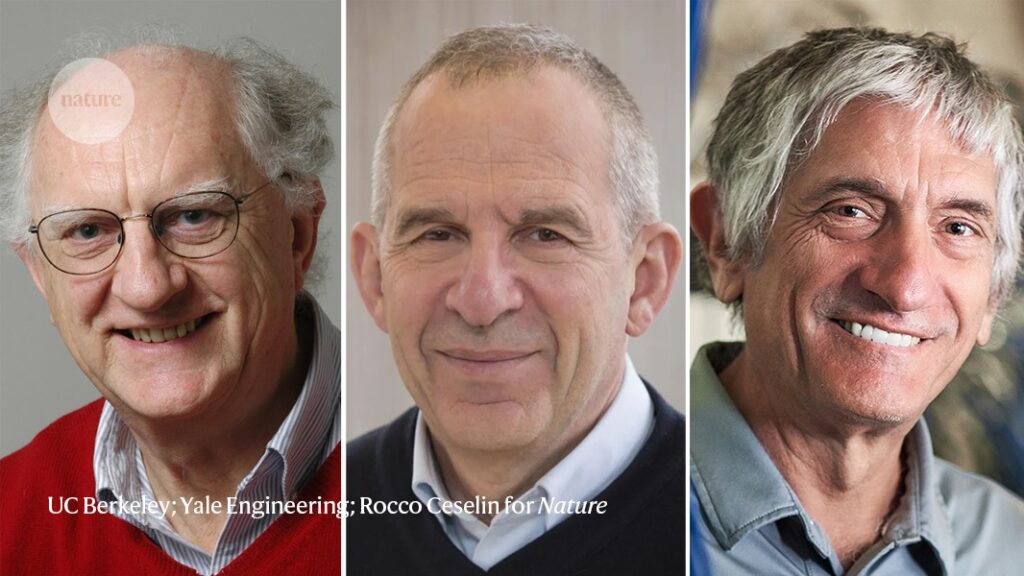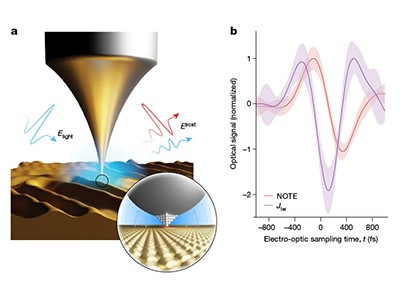John Clarke, Michel Devoret and John Martinis revealed quantum physics on a macroscopic scale. The work was a milestone for the development of superconducting quantum circuits.Credit: UC Berkeley; Yale Engineering; Rocco Ceselin for Nature
Three physicists have been awarded the 2025 Nobel Prize in Physics for demonstrating quantum physics on the macroscopic scale.
The research, including into the bizarre phenomena of quantum tunnelling and quantum superposition, has helped to underpin some of today’s most advanced quantum computers.
John Clarke at the University of California, Berkeley, Michel Devoret at Yale University in New Haven, Connecticut, and the University of California, Santa Barbara (UCSB), and John Martinis, also of USCB will share the prize of 11-million Swedish kronor (US$1.2 million), announced by the Royal Swedish Academy of Sciences in Stockholm on 7 October.
“I am completely stunned; it had never occurred to me in any way that this might be the basis for a Nobel prize,” said Clarke, speaking to journalists gathered for the announcement. “I think that our discovery in some ways is the basis of quantum computing,” he said, adding that although he led the trio’s work in the 1980s, the contributions of the other two were “overwhelming”.
Martinis told Nature that his wife had gotten the news in the middle of the night — in California time — but decided not to wake him up quite yet. “I woke up a little bit before 6. Then I opened my computer and saw John and Michel’s and my pictures.”
“It is wonderful to be able to celebrate the way that century-old quantum mechanics continually offers new surprises. It is also enormously useful, as quantum mechanics is the foundation of all digital technology,” said Olle Eriksson, a physicist at Uppsala University in Sweden and chair of the Nobel Committee for Physics.
Quantum tunnelling of electrons brings ultrafast optical microscopy to the atomic scale
Macroscopic quantum mechanics
The foundations of quantum mechanics were laid down 100 years ago. But many of its strange implications have taken decades to unravel.
One is the phenomenon of quantum tunnelling — the ability of particles to pass straight through a barrier that shouldn’t be possible according to classical physics, given its energy. Tunnelling explains radioactive decay, in which, despite being confined inside an atom, an alpha particle still has a small probability of escaping the nucleus. Another is quantum superposition, in which an object can exist simultaneously in two states.
Both tunnelling and superposition were known at the atomic scale but hadn’t been observed in macroscopic systems. In the late 1970s, Anthony Leggett, who won the 2003 Nobel Prize in Physics for his theoretical work on superconductors, asked whether the phenomena would be observable at the macroscopic scale using superconducting circuits — loops of wire which, when chilled to a fraction of a degree above absolute zero, can conduct electricity without resistance1.
“We took the question very seriously — would quantum mechanics be obeyed by these large systems? And we thought very carefully how we would prove that,” Martinis recalls. In the 1980s, Clarke, Devoret and Martinis, working at Berkeley, were among those exploring quantum effects in superconducting loops2. The trio set up an experiment in which two superconductors were separated by a thin barrier, known as a Josephson junction3. In this state, a supercurrent can flow with zero resistance, like a river that runs without friction — but also with zero voltage, so without a downhill gradient that gives the current a push. In classical physics, the system would stay stuck like this, unless given enough energy to escape.
By carefully monitoring the system, and slowly increasing the current, Clarke, Devoret and Martinis showed that the entire tiny circuit could break out into a higher energy state — by quantum tunnelling, which they observed by measuring a voltage spike. Yasunobu Nakamura, a physicist at the University of Tokyo, says that it still came as a surprise to many that quantum mechanics could manifest itself at such large scales.
“They are really pioneers of this field,” says Nakamura, who in the late 1990s became the first physicist to demonstrate a superconducting qubit bit or ‘qubit’ using a similar principle.


